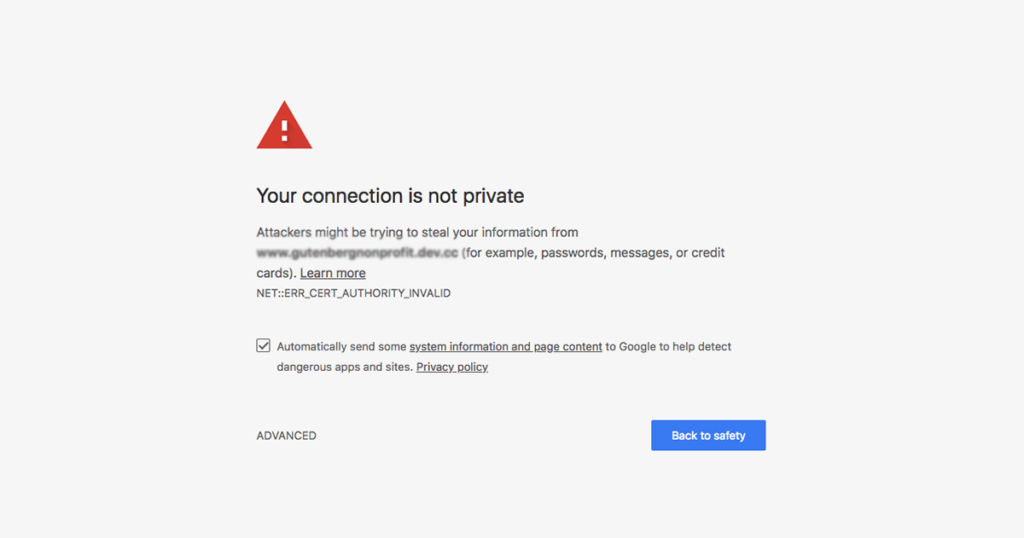Donations are the lifeblood of your organization, and your donation page is the lifeline for your cause. To get your donors to your donation page it is fundamental to implement a strong SEO strategy from the very beginning.
This article will go into depth on how you can boost your donation page Search Engine Optimization with a few simple steps, followed by a downloadable PDF checklist for you to use when you are optimizing your own page.
Get the WordPress SEO for Nonprofits eBook
We partnered with Yoast on a full guide to the fundamentals of WordPress SEO for Nonprofits. Get your copy for free now and keep your nonprofit website’s SEO strong year-round.
The Power of SEO
Search Engine Optimization (SEO) is the practice of becoming clear in your online marketing strategy and taking the appropriate steps to encourage search engines to rank your site higher in search results.
The internet is a powerful tool where people from all around the world come to seek and find the answers to their questions, the solutions to their problems, and above all else, to connect with their community. Your site is part of that community and a place for like-minded people to contribute in a positive way.
Taking care of your donations page with SEO is like taking care of your garden; it requires consistent attention and love. Your cause will grow as you reach more of your ideal audience and thus create a bigger impact in your community.
Build Your Foundation with Keyword Research
The best place to begin with your new or existing donations page is with keyword research.
Researching search queries relating to your topic offers an opportunity to get into the mind of your audience. Taking this empathic approach to your online marketing strategy leads to purposeful content creation and allows for the process of developing your donations page to be that much more impactful.
Your donations page is the lifeline of your cause. Whether you’re building a shelter for the homeless, rescuing animals in need, or running for local office, your donations page is your gateway for connecting with your audience and allowing them to connect with you.
Your visitors will seek a reason within themselves to contribute to your cause as they navigate your donations page. The purpose of your page is to lead your potential donors to make that decision without any hesitation or pause and to do so with confidence and assurance. That’s where keyword research comes in.
Keyword research (KR) is an important aspect of any online marketing strategy, however, it isn’t always clear where to begin.
Keyword Research: The Steps
- Brain Dump
- Seed Keywords & KR Tools
- Organize & Cleanup – Google Keyword Planner
Brain Dump: Get Your Ideas Out onto Paper
Before diving into the nitty-gritty of your keyword research strategy, I find that it’s best to begin by spilling all of your thoughts and ideas out onto paper (or whichever medium suits you).
This process helps to clear out and tune into your priorities. Abrain dump can help you to start fresh, especially if you’ve been feeling clogged or distracted when it comes to building your donations page. Keyword research will end up providing you with an abundance of information that you’ll be able to use not just for your donations page, but for your entire site and online marketing campaign.
Take 5 – 10 minutes to write down everything you can about your topic. Don’t hold back! Get everything out in this step. Don’t worry about organization or getting off-track.
Here are some helpful prompts to get your writing flowing:
- Who are your ideal donors? What do they care about?
- What concerns does your campaign address that your donors have?
- What are some common questions about your cause that people have?
- How do your donors feel about the cause or campaign you’re raising funds for? (Any range of emotions, thoughts, and feelings could apply here.)
- What is your campaign looking to accomplish? What will the results of your campaign look like?
Use these tools to get your thoughts flowing with even more ideas:
Ubersuggest grabs the search results from Google Suggest (the search queries found at the bottom of the search results page: “searches related to…”). Use this tool to make sure you haven’t missed any key concepts or phrases within your topic. Seek out all phrasing and verbiage that are related to your topic.
Check your keyword popularity over time to better understand where it’s been and where it’s headed with Google Trends.
Answer the Public helps you learn what questions people are asking in Google to better understand the concerns of your donors and what exactly it is that they want to know. Use this information to answer their concerns or questions within the copy of your donations page.
Nail Down Your Seed Keywords
Once you have all your ideas out on paper it’s time to refine and condense your brain dump into some general categories or groupings of your thoughts and ideas. These main phrases or concepts are your seed keywords.
Seed keywords are usually one or two words that represent a big idea. An easy way to find your seed keyword is to find words that act as an umbrella to several other topics. Seed keywords are usually pretty broad, general, and all-encompassing. They are also commonly very competitive in search.
Organize & Cleanup with Google Keyword Planner
Google Keyword Planner is your best bet for gathering the information you need without having to sign-up for a subscription or pay a monthly fee to access data. There are lots and LOTS of tools out there to utilize to expand your keyword research to new levels, but for today, Google Keyword Planner is all we need.
Gather the data you need by copy/pasting your keyword lists you’ve built into Google Keyword Planner to find the number of clicks, impressions, cost, CTR (click-through rate), and Average CPC (cost per click) for each keyword.
Using the tools mentioned earlier (Ubersuggest, Google Trends, Answer the Public) will fuel your keyword research significantly.
It’s essential that going into your research, you have a plan for organizing your data. I prefer to use Google Docs to build a shared spreadsheet so I can collaborate with anyone involved in content writing or promotion.
Build your Google Doc so that each tab within your document is labeled with one of the seed keywords you found. Fill up each sheet with all the related terms you found and use this space as a home for all your keyword ideas. Here you can begin prioritizing and trimming your lists.
I’ve built an example of what my keyword research looks like for a local community farm with a CSA offering here.
Be Aware of Your On-Page Optimization Needs
It’s easy to pass up important, seemingly small details in terms of your donations page. Things like your title, permalink, alt-tags, and meta-description are all crucial elements of your page that will help search engines learn about your page (and your overall site for that matter).
Taking care of the small details of your donations page will improve how your page visitors (potential donors) understand your page just as much as search engines. That’s the best part of SEO, by approaching your strategy from a place of empathy, you’re connecting both with your target audience AND search engines.
Here are the key elements on your page you’ll want to make sure are optimized:
- Titles: Use headings (titles) to break up your content. Be sure to include your target keyword(s) within your headings at least once. Be creative and engaging with your title writing. Title tags look like this: <H1> <H2>, etc.
- Meta-Descriptions: Be clear and concise, include your target keyword. There are SEO plugins available to help you build meta descriptions that are optimized for Search Engines, like Yoast or All-in-One SEO.
- Alt-Tags (Optimizing Images): Use your target keyword in the alt -tags for at least one image on the page and be as descriptive as possible.
- Optimize Your Page for Mobile: Test your landing page on as many devices as possible. Ensure that your page is responsive and functional across all devices.
- Make Your Forms Concise: Ask for only the information you absolutely need. Don’t overwhelm your donors with a form that’s too long or too invasive.
- Limit Distractions: Once someone lands on your donations page, there’s only one thing you want them to do: make a donation. Remove your site’s standard navigation from this page and keep the focus narrowed in on your campaign.
- Google Analytics & Give: Use Google Analytics Donation Tracking Add-on with Give to keep track of important information like page views, engagement, conversions, and more.
Build Trust with Your Donors
Your donors are opting to share sensitive information with you when making a donation. It’s important that there’s a sense of safety in order for your donors to feel protected when entering their credit card and other personal data.
The best way to establish this sense of safety is by encrypting your website with an SSL certificate. This is something that’s required for certain payment gateways, which is just all the more reason to make sure your site is encrypted.
An SSL helps prevent security warnings from popping up before visitors view your site as well. You don’t want your site to cause a message like the one below.
You might also consider adding a badge from your payment processor to offer additional proof that your donor’s information is in good hands.
Another simple way to build trust with your donors is to provide your privacy policy somewhere on your page. Include a link within the footer of your website, this way it will be available across your website.
Consider Accessibility: Our colleague from Unity teaches us that “the internet isn’t one size fits all” and provides some simple tools to consider in this article about accessibility.
Keep it simple: Go back and check your form fields and your page’s info. Are you collecting only the information you need? Are you asking your donor to do multiple things on your page? Limit your donation experience to one step: making a donation. That’s it.
Keep your donors on your site: Utilize one of Give’s payment gateways to keep your donors on your site throughout the donation process and avoid any donor drop-offs. This functionality will build confidence with your donors as well as smooth out the donation experience as a whole.
There are a lot of things to consider in online security, for more information, take a look at some of our past articles on the subject.
More About Building Trust with Donors About GDPR Considerations
Inspire Action by Creating Compelling Content
Any page that’s optimized well has a clear and engaging call to action. When it comes to your donations page, your call to action is your call for donations. The rest of your page should support this request.
As you establish content for your page, consider the most important considerations your donors will have when it comes to taking a leap by investing in your cause. What do they need to know? What will make them feel confident that their contribution will make a difference?
Some of my favorite ways to inspire action:
- Develop comprehensive content. Ease your audience into taking action that feels really good for them in the moment. Use data and compelling facts to tell a story and entice your donors to engage.
- Add tiered levels of giving to your form: Guide your donors to select the giving level you most want them to choose. Offer multiple giving options instead of just having them type a dollar amount in. Make your most desired level the default.
- Incentivize with suggested gift amounts. Make good use of your donation levels by offering a powerful argument for each level.
- Make your campaign time-sensitive. Displaying campaign goals can encourage your donors to act now. Take it a step further by setting time limits on your campaigns.
- Spruce up your Donation Confirmation Page: Give’s [donation_receipt] shortcode offers a detailed summary of your donor’s donation upon receipt of payment. Take your confirmation page a step further by adding content like a gratitude message or a video. Encourage your donors to engage with you on social media, on your blog, sign up for your newsletter, or take some other kind of action.
Promotion, Promotion, Promotion!
Your landing page is built. Your copy is written. Your forms are ready to go.
It may seem fair to assume that the majority of your work is complete, however, I’d argue that your work has only just begun.
Promotion is key to the consistent growth and nurturing of your donations page. The beautiful, impactful page you’ve created won’t get the attention it deserves (or the rankings you desire) without active promotion.
Use these strategies to fine-tune your promotion skills:
- Tap into your lists. Your email lists will come in handy once your donations page is ready for the public. Send your email subscribers a news blast about your newest campaign. Share your donations page along with some enticing copy to get them to click. Then, follow up!
- Connect on Social. Utilize your social networks to share your new campaign. Bonus points if you spark a collaboration with someone in your industry or someone who’s passionate about your cause. Social media allows us to tap into our creativity to foster connection. Don’t be shy!
- Follow-up: Once you have a decent list of donors to communicate with, follow-up! Send out emails or give your donors a call to thank them for their donation. Give them a heads up if there are any changes to your campaign or any news to share. Your donors made a contribution because they care. Show them that you care about them, too!
Get the WordPress SEO for Nonprofits eBook
We partnered with Yoast on a full guide to the fundamentals of WordPress SEO for Nonprofits. Get your copy for free now and keep your nonprofit website’s SEO strong year-round.







